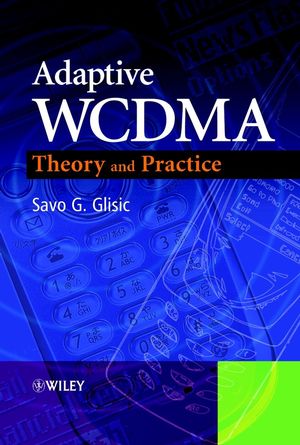Adaptive WCDMA: Theory and PracticeISBN: 978-0-470-84825-8
Hardcover
628 pages
February 2003
 This is a Print-on-Demand title. It will be printed specifically to fill your order. Please allow an additional 15-20 days delivery time. The book is not returnable.
|
||||||
Preface xiii
1 Fundamentals 1
1.1 Adaptive Communications and the Book Layout 1
1.2 Spread Spectrum Fundamentals 10
1.3 Theory versus Practice 16
References 19
2 Pseudorandom sequences 23
2.1 Properties of Binary Shift Register Sequences 23
2.2 Properties of Binary Maximal-Length Sequence 26
2.3 Sets of Binary Sequences with Small Cross-Correlation Maximal Connected Sets of m-Sequences 30
2.4 Gold Sequences 30
2.5 Goldlike and Dual-BCH Sequences 33
2.6 Kasami Sequences 33
2.7 JPL Sequences 35
2.8 Kroncker Sequences 36
2.9 Walsh Functions 36
2.10 Optimum PN Sequences 37
2.11 Theory and Practice of PN Codes 39
2.12 PN Matched Filter 39
Symbols 40
References 41
3 Code acquisition 43
3.1 Optimum Solution 43
3.2 Practical Solutions 45
3.3 Code Acquisition Analysis 46
3.4 Code Acquisition in CDMA Network 51
3.5 Modeling of the Serial Code Acquisition Process for RAKE Receivers in CDMA Wireless Networks with Multipath and Transmitter Diversity 54
3.6 Two-Dimensional Code Acquisition in Spatially and Temporarily White Noise 57
3.7 Two-Dimensional Code Acquisition in Environments with Spatially Nonuniform Distribution of Interference 62
3.8 Cell Search in W-CDMA 71
References 75
4 Code tracking 79
4.1 Code-Tracking Loops 79
4.2 Code Tracking in Fading Channels 87
4.3 Signal Subspace-Based Channel Estimation for CDMA Systems 94
4.4 Turbo Processor Aided RAKE Receiver Synchronization for UMTS W-CDMA 102
Appendix: Linear and Matrix Algebra 114
References 120
5 Modulation and demodulation 123
5.1 Maximum Likelihood Estimation 123
5.2 Frequency-Error Detection 125
5.3 Carrier Phase Measurement: Nonoffset Signals 129
5.4 Performance of the Frequency and Phase Synchronizers 136
Symbols 145
References 145
6 Power control 147
6.1 Algorithms 147
6.2 Closed-Loop Power Control in DS-CDMA Cellular System: Problem Definition 150
6.3 Reference Power Level 156
6.4 Feedback Control Loop Analysis 159
6.5 Nonlinear Power Control 163
6.6 Fuzzy Logic Power Control 165
6.7 Imperfect Power Control in CDMA Systems 177
6.8 Adaptive Communications 182
Symbols 185
References 186
7 Interference suppression and CDMA overlay 191
7.1 Narrowband Interference Suppression 191
7.2 Generalization of Narrowband Interference Suppression 194
7.3 Recursive Solutions for the Filter Coefficients 198
7.4 The Learning Curve and its Time Constant 203
7.5 Practical Applications: CDMA Network Overlay 210
References 214
8 CDMA network 217
8.1 CDMA Network Capacity 217
8.2 Cellular CDMA Network 220
8.3 Impact of Imperfect Power Control 228
8.4 Channel Modeling in CDMA Networks 235
8.5 RAKE Receiver 249
8.6 CDMA Cellular System with Adaptive Interference Cancellation 254
8.7 Diversity Handover in DS-CDMA Cellular Systems 258
Symbols 267
References 270
9 CDMA network design 271
9.1 Basic System Design Philosophy 271
9.2 CDMA Network Planning 278
9.3 Spectral Efficiency of WCDMA 289
Symbols 292
References 292
10 Resource management and access control 295
10.1 Power Control and Resource Management for a Multimedia CDMA Wireless System 295
10.2 Access Control of Data in Integrated Voice/Data in CDMA Systems 300
10.3 Delta Modulation–Based Prediction for Access Control in Integrated Voice/Data CDMA Systems 308
10.4 Mixed Voice/Data Transmission using PRMA Protocol 313
10.5 Fuzzy/Neural Congestion Control 320
10.6 Adaptive Traffic Admission Based on Kalman Filter 331
10.7 Soft Handoff in CDMA Cellular Networks 343
10.8 A Measurement-Based Prioritization Scheme for Handovers 354
Symbols 364
References 365
11 CDMA packet radio networks 369
11.1 Dual-Class CDMA System 369
11.2 Access Control for Wireless Multicode CDMA Systems 375
11.3 Reservation-Code Multiple Access 379
11.4 MAC Protocol for a Cellular Packet CDMA with Differentiated QoS 386
11.5 CDMA ALOHA Network Using p-Persistent CSMA/CD Protocol 390
11.6 Implementation Losses in MAC Protocols in Wireless CDMA Networks 397
11.7 Radio Resource Management in Wireless IP Networks and Differentiated Services 404
References 418
12 Adaptive CDMA networks 421
12.1 Bit Rate/Space Adaptive CDMA Network 421
12.2 MAC Layer Packet Length Adaptive CDMA Radio Networks 433
Appendix 451
References 452
13 Multiuser CDMA receivers 455
13.1 Optimal Receiver 455
13.2 Linear Multiuser CDMA Detectors 460
13.3 Multistage Detection in Asynchronous CDMA 462
13.4 Noncoherent Detector 465
13.5 Multiuser Detection in Frequency Nonselective Rayleigh Fading Channel 470
13.6 Multiuser Detection in Frequency-Selective Rayleigh Fading Channel 476
Symbols 487
References 488
14 MMSE multiuser detectors 491
14.1 Minimum Mean-Square Error (MMSE) Linear Multiuser Detection 491
14.2 System Model in Multipath Fading Channel 494
14.3 MMSE Detector Structures 497
14.4 Spatial Processing 500
14.5 Single-User LMMSE Receivers for Frequency-Selective Fading Channels 503
Symbols 516
References 516
15 Wideband CDMA network sensitivity 519
15.1 Theory and Practice of Multiuser Detection 519
15.2 System Model 521
15.3 Capacity Losses 527
15.4 Near Far Self-Resistant CDMA Wireless Network 537
Appendix 1 Coherent Detection of (mMτ-CDMA) 549
Appendix 2 Coherent Detection of (amMτ-CDMA) 553
Appendix 3 Noncoherent Detection of (mMτ-CDMA) 556
Appendix 4 Noncoherent Detection of (amMτ-CDMA) 559
References 562
16 Standards 565
16.1 IS 95 Standard 565
16.2 IS-95B CDMA 575
16.3 CDMA2000 575
16.4 IS-665 W-CDMA 581
References 588
17 UMTS standard: WCDMA/FDD Layer 1 591
17.1 Transport Channels and Physical Channels (FDD) 591
17.2 Multiplexing, Channel Coding and Interleaving 598
17.3 Spreading and Modulation 600
17.4 Physical Layer Procedures (FDD) 604
References 607
Index 609



